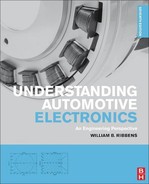Introduction
This book covers the general topic of the application of electronics in automobiles and light trucks. Some of the technology described herein is also found in large trucks and other land vehicles, although these applications are not explicitly discussed.
The only important use of electronics in automobiles through the late 1950s was the broadcast band radio receiver, which was based upon vacuum tube technology. The development of solid-state electronics, from the first transistors through the latest high performance integrated circuits, came at a time that permitted the very sophisticated electronic systems discussed in this book to be applied to solving automotive control and instrumentation problems.
The book is organized in a way that allows the reader to select his/her own desired starting point depending upon background and/or experience. The first two chapters provide a review of linear system theory at the level found throughout the remainder of the book.
The new first and second chapters present a survey of various aspects of linear system theory. The new first chapter discuses continuous time (analog) theory and the new second chapter discuses discrete time (digital) system theory. Neither of these two chapters has sufficient breadth or depth to serve as a full ab initio presentation of system theory. For many readers, they will be redundant. Nevertheless, they provide a review of linear system theory and introduce notation that is used throughout this book.
Chapter 3 discusses the basics of solid-state active elements (e.g. diodes and various types of transistors) along with circuits that form the basic building blocks of automotive electronic systems. Chapter 4 discusses microprocessors/microcontrollers and certain fundamental aspects of their application in automotive electronic systems. Chapter 5 presents the fundamentals of electronic engine control. Chapter 6 surveys sensors and actuators found in automotive electronic control or instrumentation systems that are arguably the most important components in such systems. The remaining chapters discuss specific automotive systems that incorporate electronics for control or instrumentation purposes. The automotive components/systems covered include engine, drivetrain, suspension, steering, brakes, instrumentation, telematics and diagnostics as well as motion control. All of the mathematical models and performance analyses are given in terms of the theory and methods of the first and second chapters. Extensive use is made of contemporary computer simulation.
Specific examples are presented for most electronic systems/components for which component models and performance analyses are given. These examples are based upon simplified models and linear system theory such that the basic principles involved are illustrated without the cumbersome mathematical details (and nonlinearities) that are often found in the analysis of practical production vehicle systems.
Furthermore, the examples given in this book of any component/system are representative of those found in any production vehicle. Proprietary issues prohibit the detailed discussion of such production items. In addition, the technology of automotive electronics found in production vehicles is constantly evolving and any detailed discussion of a given vehicle electronic system as of the writing of this book might well be obsolete in the next model year.
There is an important notational issue concerning the analytical portions of this book. There are many variables and parameters involved in the various components/systems discussed in each chapter. The symbols used in this book include upper and lower case Roman and Greek (often subscripted) letters. However, the reader should be aware that these symbols do not have a global definition throughout the book. Rather, each symbol is defined for the section of the book in which it is used.
The units and dimensions for variables discussed in this book are English in keeping with earlier editions, even though the worldwide automotive industry uses essentially all metric units. However, conversion tables from English to metric units are readily available. Moreover, those readers in the USA, having relatively limited backgrounds in the physical sciences, are likely to be more familiar with English rather than metric units. Readers having backgrounds in the sciences will find unit conversion straightforward.
